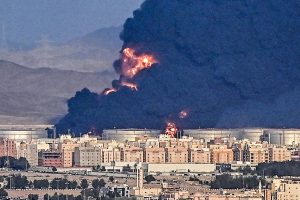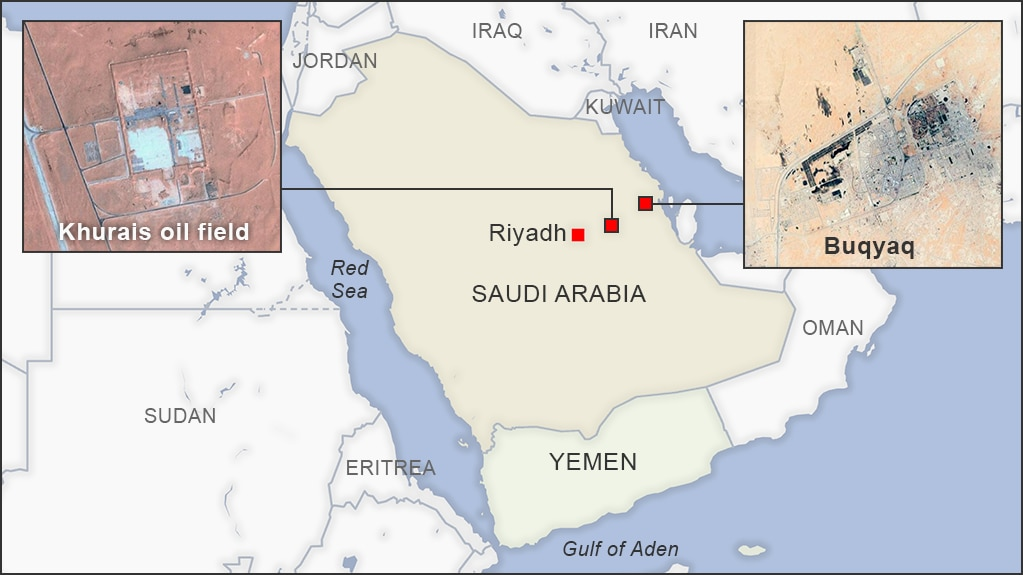On September 14, 2019, Yemen’s Ansar Allah (the Houthi movement) launched one of the most devastating attacks on global energy infrastructure in history. A coordinated drone and missile strike targeted Saudi Aramco’s Abqaiq oil processing facility and the Khurais oil field, temporarily crippling nearly half of Saudi Arabia’s oil production and sending shockwaves through global energy markets.
This attack marked a turning point in the Yemeni conflict, demonstrating the Houthis’ ability to strike deep inside Saudi Arabia and disrupt the world’s largest oil exporter. The aftermath saw oil prices surge, emergency responses from global powers, and long-term shifts in energy security strategies.
In this in-depth analysis, we examine:
- How the attack unfolded
- The immediate and long-term impacts on oil production and exports
- The geopolitical consequences for Saudi Arabia, Yemen, and global energy markets
- Lessons learned and future risks

Credit: Wikipedia
The September 2019 Attack: What Happened?
On September 14, 2019, Yemen’s Houthi rebels launched a coordinated drone and missile attack on Saudi Aramco’s Abqaiq oil processing facility and Khurais oil field in eastern Saudi Arabia. The strike, one of the most damaging in the history of global energy infrastructure, temporarily halved Saudi Arabia’s oil production—cutting nearly 5% of the world’s daily oil supply. The attack caused a sharp spike in oil prices and exposed vulnerabilities in Saudi Arabia’s air defenses. While the Houthis claimed responsibility, the U.S. and Saudi Arabia blamed Iran, alleging it supplied the weapons and expertise. The incident heightened tensions in the Persian Gulf and underscored the growing risks to global energy security from regional conflicts.
1. The Targets: Abqaiq and Khurais
-
Abqaiq: The world’s largest oil processing facility, handling ~7 million barrels per day (bpd)—about 70% of Saudi Arabia’s crude output.
-
Khurais: A major oil field producing ~1.5 million bpd.
2. The Attack Method
-
Drones & Cruise Missiles: A swarm of 18 drones and 7 cruise missiles struck with precision, bypassing Saudi defenses.
-
Origin Debate: While Ansar Allah claimed responsibility, U.S. and Saudi officials initially suspected Iranian involvement due to the attack’s sophistication.
3. Immediate Damage
-
Abqaiq: 17 out of 18 stabilization towers were hit, severely disrupting processing capacity.
-
Khurais: Two major oil separation units were damaged.
-
Result: 5.7 million bpd of production halted—equivalent to 5% of global oil supply.

Credit: https://www.cnbc.com/2022/03/25/reports-of-huge-fire-at-aramco-oil-facility-in-saudi-arabia.html
Impact on Oil Production and Exports
1. Production Shutdowns
-
Initial Loss: 5.7 million bpd (50% of Saudi output).
-
Recovery Time: Aramco restored ~4 million bpd within 10 days, but full recovery took weeks.
2. Export Disruptions
-
Saudi Arabia declared force majeure, delaying shipments to key buyers (China, India, U.S., Europe).
-
Global oil prices spiked:
-
Brent crude surged 20% (biggest intraday jump since 1991 Gulf War).
-
Prices briefly hit $71 per barrel before stabilizing.
-
3. Strategic Reserves Activated
-
Saudi Arabia tapped into its inventories to maintain exports.
-
The U.S. considered releasing SPR (Strategic Petroleum Reserve) but held off due to Aramco’s rapid recovery.
Geopolitical Fallout
The 2019 drone and missile strikes on Saudi Aramco’s Abqaiq and Khurais facilities exposed critical vulnerabilities in Saudi Arabia’s defense infrastructure, despite billions invested in U.S.-made Patriot missile systems, which failed to intercept the low-flying drones and cruise missiles 28. The attacks prompted Riyadh to accelerate defense upgrades, including laser systems and drone-jamming technology, while reassessing its reliance on traditional air defense networks 29. The incident also intensified U.S.-Iran tensions, with Washington blaming Tehran for orchestrating the attack and imposing new sanctions on Iran’s Central Bank, despite Iran’s denials. U.N. investigators and Western intelligence agencies, however, cited evidence of Iranian-made components in the Houthi-launched weapons 2810. In Yemen, the attack bolstered the Houthis’ negotiating position, as Saudi Arabia—facing economic and security pressures—initiated indirect talks with the group to mitigate future threats and explore a ceasefire, marking a shift in its wartime strategy 4811. The strikes underscored how regional proxy conflicts could destabilize global energy markets, with the disruption of 5% of world oil supply triggering a sharp price spike and exposing the interconnected risks of Middle Eastern geopolitics 812.
– Saudi Arabia’s Vulnerability Exposed
Despite billions spent on U.S. Patriot missile systems, the attack succeeded. Riyadh accelerated defense upgrades, including laser systems and drone-jamming tech.
– U.S. and Iran Tensions Escalate
U.S. blamed Iran, imposing new sanctions. However, Iran denied involvement.
– Impact on the Yemen War
The attack strengthened Houthi leverage in peace talks. Saudi Arabia began indirect negotiations to reduce future threats.
–
Long-Term Consequences for Global Oil Markets
1. Energy Security Reevaluated
-
Countries reassessed reliance on Middle Eastern oil.
-
Diversification efforts (U.S. shale, renewables) gained momentum.
2. Oil Price Volatility
-
The attack introduced a new risk premium in oil markets.
-
Traders now factor in Houthi strike risks when pricing crude.
3. Aramco’s IPO and Investor Confidence
-
The attack occurred just weeks before Aramco’s IPO, raising investor concerns.
-
Saudi Arabia had to reassure markets about long-term stability.
–
Could It Happen Again? Future Risks
The 2019 Abqaiq-Khurais attack demonstrated how vulnerable even the most critical energy infrastructure is to asymmetric warfare. Since then, the Houthis have significantly expanded their capabilities, while Saudi Arabia and its allies have bolstered defenses. However, lessons from the Ukraine-Russia drone war suggest that such attacks could recur—with even greater consequences—if regional tensions escalate again.
1. Houthi Capabilities Have Grown
- Longer-Range Drones & Missiles: The Houthis now possess advanced drones like the Sammad-3 (1,500 km range) and cruise missiles such as the Quds-1, enabling strikes deep into Saudi Arabia, the UAE, and even Israel .
- Precision Strikes Continue: Since 2022, Houthi attacks have targeted Riyadh’s airports, Jeddah oil depots, and Red Sea shipping lanes, proving their ability to sustain high-impact operations .
- Iranian Backing & Technological Upgrades: Recent seizures reveal the Houthis are integrating jet engines and first-person view (FPV) drones, mirroring tactics used by Russia in Ukraine to overwhelm air defenses .
→ Ukraine War Parallel: Russia’s Shahed drone swarms (produced at 2,700/month) show how cheap, mass-produced drones can bypass even advanced defenses. The Houthis, with Iranian support, could adopt similar saturation tactics against Gulf oil facilities .
2. Saudi Defenses Improved but Not Foolproof
- Enhanced Air Defenses: Saudi Arabia has deployed additional Patriot batteries, laser systems, and drone-jamming tech since 2019 .
- Early Warning Systems: Improved radar and intelligence-sharing with the U.S. help detect incoming threats earlier .
- Critical Weaknesses Remain:
-
-
Drone swarms (like those used in Ukraine) can overwhelm interceptors due to their low cost ($20,000/drone vs. $4M/Patriot missile) .
-
Low-altitude cruise missiles evade traditional radar, as seen in the 2019 attack .
-
Decentralized Houthi launch sites (mobile trucks, hidden in Yemen’s mountains) make preemptive strikes difficult .
-
→ Ukraine War Lesson: Despite NATO-supplied air defenses, Russian drones still penetrate Ukrainian cities regularly. Saudi Arabia faces a similar challenge: no system is 100% effective against saturation attacks .
3. Diplomatic Solutions?
- Ongoing Saudi-Houthi Talks: Since 2022, indirect negotiations have reduced cross-border strikes, with the Houthis seeking concessions (e.g., lifting Saudi blockade, sharing oil revenue) .
- Risks if Talks Fail: A breakdown could trigger a new wave of attacks, especially if the Houthis feel militarily emboldened. Regional Escalation: Strikes on UAE or Bahraini facilities could drag the U.S. deeper into the conflict .
- Iran’s Role: Tehran may escalate Houthi attacks to pressure Saudi Arabia or retaliate for U.S./Israeli actions .
→ Ukraine War Parallel: Just as Russia uses drones to bypass stalemates on the battlefield, the Houthis could escalate asymmetrically if diplomacy stalls, targeting oil infrastructure to inflict economic pain .
–
Conclusion
The September 2019 Abqaiq-Khurais attack was a wake-up call for global energy security. It proved that non-state actors like Ansar Allah can disrupt the world’s oil supply chain with relatively low-cost drone warfare. While Saudi Arabia recovered quickly, the long-term risks remain. Future attacks could trigger even worse supply shocks, especially if Iran-Houthi coordination deepens.
For oil markets, the lesson is clear: geopolitical instability in the Middle East remains the biggest threat to energy security. Investors, governments, and militaries must prepare for a new era of asymmetric oil warfare.
Read more here:
Can Iran Block the Strait of Hormuz? Implications for International Transport, Economy, and Trade
References
-
The September 2019 Attack on Abqaiq and Khurais
-
Impact on Oil Production & Prices
-
Geopolitical Reactions & U.S.-Iran Tensions
-
Houthi Capabilities & Future Risks
-
Saudi Defense Upgrades & Energy Security
-
Aramco’s Financial & Market Response


5 thoughts on “Rememberance of Yemen’s Attack on Saudi Aramco-Abqaiq at Persian Gulf in Sep 2019: Analysis of Its Impact on Global Oil Markets”